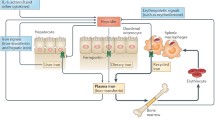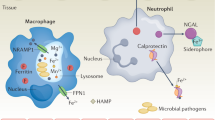Abstract
Iron is an essential nutrient for all living organisms with critical roles in many biological processes. The mammalian host maintains the iron requirements by dietary intake, while the invading pathogenic bacteria compete with the host to obtain those absorbed irons. In order to limit the iron uptake by the bacteria, the human host employs numerous iron binding proteins and withholding defense mechanisms that capture iron from the microbial invaders. To counteract, the bacteria cope with the iron limitation imposed by the host by expressing various iron acquisition systems, allowing them to achieve effective iron homeostasis. The armamentarium used by the human host and invading bacteria, leads to the dilemma of who wins the ultimate war for iron.


Similar content being viewed by others
References
DiGuiseppi J, Fridovich I (1982) Oxygen toxicity in Streptococcus sanguis. J Biol Chem 257:4046–4051
Archibald F (1983) Lactobacillus plantarum, an organism not requiring iron. FEMS Microbiol Lett 19:29–32. https://doi.org/10.1016/0378-1097(83)90353-1
Posey JE, Gherardini FC (2000) Lack of role for iron in lyme disease pathogen. Science (80) 288:1651–1653. https://doi.org/10.1126/science.288.5471.1651
Posey JE, Hardham JM, Norris SJ, Gherardini FC (1999) Characterization of a manganese-dependent regulatory protein, TroR, from Treponema pallidum. Proc Natl Acad Sci USA 96:10887–10892. https://doi.org/10.1073/pnas.96.19.10887
Chen L, Zheng D, Liu B et al (2016) VFDB 2016: hierarchical and refined dataset for big data analysis—10 years on. Nucleic Acids Res 44:D694–D697. https://doi.org/10.1093/nar/gkv1239
Symeonidis A, Marangos M (2012) Iron and microbial growth. In: Insight and control of Infectious disease in global scenario. InTech, pp. 289–330. https://doi.org/10.5772/34760
Von Drygalski A, Adamson JW (2013) Iron metabolism in man. J Parenter Enter Nutr 37:599–606. https://doi.org/10.1177/0148607112459648
Andrews NC, Schmidt PJ (2007) Iron homeostasis. Annu Rev Physiol 69:69–85. https://doi.org/10.1146/annurev.physiol.69.031905.164337
Schaible UE, Kaufmann SH (2004) Iron and microbial infection. Nat Rev Microbiol 2:946–953. https://doi.org/10.1038/nrmicro1116
Messenger AJ, Barclay R (1983) Bacteria, iron and pathogenicity. Biochem Educ 11:54–63. https://doi.org/10.1016/0307-4412(83)90043-2
Andrews SC, Robinson AK, Rodríguez-Quiñones F (2003) Bacterial iron homeostasis. FEMS Microbiol Rev 27:215–237. https://doi.org/10.1016/S0168-6445(03)00055-X
Cornelis P, Wei Q, Andrews SC, Vinckx T (2011) Iron homeostasis and management of oxidative stress response in bacteria. Metallomics 3:540–549. https://doi.org/10.1039/c1mt00022e
Wandersman C, Delepelaire P (2004) Bacterial iron sources: from siderophores to hemophores. Annu Rev Microbiol 58:611–647. https://doi.org/10.1146/annurev.micro.58.030603.123811
Hennigar SR, McClung JP (2016) Nutritional immunity: starving pathogens of trace minerals. Am J Lifestyle Med. https://doi.org/10.1177/1559827616629117
Indriati Hood M, Skaar EP (2012) Nutritional immunity: transition metals at the pathogen-host interface. Nat Rev Microbiol. https://doi.org/10.1086/498510.Parasitic
McLaren GD, Muir WA, Kellermeyer RW, Jacobs A (1983) Iron overload disorders: natural history, pathogenesis, diagnosis, and therapy. CRC Crit Rev Clin Lab Sci 19:205–266. https://doi.org/10.3109/10408368309165764
Khan FA, Fisher MA, Khakoo RA (2007) Association of hemochromatosis with infectious diseases: expanding spectrum. Int J Infect Dis 11:482–487. https://doi.org/10.1016/j.ijid.2007.04.007
Gangaidzo IT, Moyo VM, Mvundura E et al (2001) Association of pulmonary tuberculosis with increased dietary iron. J Infect Dis 184:936–939. https://doi.org/10.1086/323203
Canziani MEF, Yumiya ST, Rangel EB et al (2001) Risk of bacterial infection in patients under intravenous iron therapy: dose versus length of treatment. Artif Organs 25:866–869. https://doi.org/10.1046/j.1525-1594.2001.06894.x
Maynor L, Brophy DF (2007) Risk of infection with intravenous iron therapy. Ann Pharmacother 41:1476–1480. https://doi.org/10.1345/aph.1K187
Taylor RW, Manganaro L, O’Brien J et al (2002) Impact of allogenic packed red blood cell transfusion on nosocomial infection rates in the critically ill patient. Crit Care Med 30:2249–2254. https://doi.org/10.1097/01.CCM.0000030457.48434.17
Palmer KT, Poole J, Ayres JG et al (2003) Exposure to metal fume and infectious pneumonia. Am J Epidemiol 157:227–233. https://doi.org/10.1093/aje/kwf188
Weinberg ED (2009) Iron availability and infection. Biochim Biophys Acta—Gen Subj 1790:600–605. https://doi.org/10.1016/j.bbagen.2008.07.002
Kumar V, Choudhry VP (2010) Iron deficiency and infections. Indian J Pediatr 77:789–793
Chung MC-M (1984) Structure and function of transferrin. Biochem Educ 12:146–154. https://doi.org/10.1017/CBO9781107415324.004
Otto BR, Verweij-van Vught AM, MacLaren DM (1992) Transferrins and heme-compounds as iron sources for pathogenic bacteria. Crit Rev Microbiol 18:217–233. https://doi.org/10.3109/10408419209114559
Thorstensen K, Romslo I (1990) The role of transferrin in the mechanism of cellular iron uptake. Biochem J 271:1–9
Farnaud S, Evans RW (2003) Lactoferrin—a multifunctional protein with antimicrobial properties. Mol Immunol 40:395–405. https://doi.org/10.1016/S0161-5890(03)00152-4
Ward PP, Conneely OM (2004) Lactoferrin: role in iron homeostasis and host defense against microbial infection. Biometals 17:203–208. https://doi.org/10.1023/B:BIOM.0000027693.60932.26
Ward PP, Paz E, Conneely OM (2005) Multifunctional roles of lactoferrin: a critical overview. Cell Mol Life Sci 62:2540–2548. https://doi.org/10.1007/s00018-005-5369-8
Vorland LH (1999) Lactoferrin: a multifmctional glycoprotein. Acta Pathol Microbiol Immunol Scand 107:971–981
Orino K, Watanabe K (2008) Molecular, physiological and clinical aspects of the iron storage protein ferritin. Vet J 178:191–201. https://doi.org/10.1016/j.tvjl.2007.07.006
Reif DW (1992) Ferritin as a source of iron for oxidative damage. Free Radic Biol Med 12:417–427. https://doi.org/10.1016/0891-5849(92)90091-T
Arosio P, Levi S (2002) Ferritin, iron homeostasis, and oxidative damage. Free Radic Biol Med 33:457–463. https://doi.org/10.1016/S0891-5849(02)00842-0
Arosio P, Ingrassia R, Cavadini P (2009) Ferritins: a family of molecules for iron storage, antioxidation and more. Biochim Biophys Acta 1790:589–599. https://doi.org/10.1016/j.bbagen.2008.09.004
Theil EC (2003) Ferritin: at the crossroads of iron and oxygen metabolism. J Nutr 133:1549–1553
Carrondo MA (2003) Ferritins, iron uptake and storage from the bacterioferritin viewpoint. EMBO J 22:1959–1968. https://doi.org/10.1093/emboj/cdg215
Anzaldi LL, Skaar EP (2010) Overcoming the heme paradox: heme toxicity and tolerance in bacterial pathogens. Infect Immun 78:4977–4989. https://doi.org/10.1128/IAI.00613-10
Tong Y, Guo M (2009) Bacterial heme-transport proteins and their heme-coordination modes. Arch Biochem Biophys 481:1–15. https://doi.org/10.1016/j.abb.2008.10.013
Pieracci FM, Barie PS (2005) Iron and the risk of infection. Surg Infect (Larchmt) 6:41–46. https://doi.org/10.1089/sur.2005.6.s1
Parrow NL, Fleming RE, Minnick MF (2013) Sequestration and scavenging of iron in infection. Infect Immun 81:3503–3514. https://doi.org/10.1128/IAI.00602-13
Saha R, Saha N, Donofrio RS, Bestervelt LL (2013) Review microbial siderophores: a mini review. J Basic Microbiol 53:303–317. https://doi.org/10.1002/jobm.201100552
Miethke M, Marahiel MA (2007) Siderophore-based iron acquisition and pathogen control. Microbiol Mol Biol Rev 71:413–451. https://doi.org/10.1128/MMBR.00012-07
Hotta K, Kim CY, Fox DT, Koppisch AT (2010) Siderophore-mediated iron acquisition in Bacillus anthracis and related strains. Microbiology 156:1918–1925. https://doi.org/10.1099/mic.0.039404-0
Cornelis P, Dingemans J (2013) Pseudomonas aeruginosa adapts its iron uptake strategies in function of the type of infections. Front Cell Infect Microbiol 3:75. https://doi.org/10.3389/fcimb.2013.00075
Skaar EP (2010) The battle for iron between bacterial pathogens and their vertebrate hosts. PLoS Pathog 6:1–2. https://doi.org/10.1371/journal.ppat.1000949
Evans RW, Oakhill JS (2002) Transferrin-mediated iron acquisition by pathogenic Neisseria. Biochem Soc 30:705–707. https://doi.org/10.1042/bst0300705
Noinaj N, Easley NC, Oke M et al (2012) Structural basis for iron piracy by pathogenic Neisseria. Nature 483:53–58. https://doi.org/10.1038/nature10823
Genco CA, Desai PJ (1996) Iron acquisition in the pathogenic Neisseria. Trends Microbiol 4:179–184. https://doi.org/10.1016/0966-842X(96)10029-9
Schryvers AB, Stojiljkovic I (1999) Iron acquisition systems in the pathogenic Neisseria. Mol Microbiol 32:1117–1123. https://doi.org/10.1046/j.1365-2958.1999.01411.x
Gray-Owen SD, Loosmore S, Schryvers AB (1995) Identification and characterization of genes encoding the human transferrin-binding proteins from Haemophilus influenzae. Infect Immun 63:1201–1210
Loosmore SM, Yang YP, Coleman DC et al (1996) Cloning and expression of the Haemophilus influenzae transferrin receptor genes. Mol Microbiol 19:575–586
Herrington DA, Sparling PF (1985) Haemophilus influenzae can use human transferrin as a sole source for required iron. Infect Immun 48:248–251
Gonzalez GC, Caamano DL, Schryvers AB (1990) Identification and characterization of a porcine-specific transferrin receptor in Actinobacillus pleuropneumoniae. Mol Microbiol 4:1173–1179. https://doi.org/10.1111/j.1365-2958.1990.tb00692.x
Perkins-Balding D, Ratliff-Griffin M, Stojiljkovic I (2004) Iron transport systems in Neisseria meningitidis. Microbiol Mol Biol Rev 68:154–171. https://doi.org/10.1128/MMBR.68.1.154
Criado MT, Pintor M, Ferreirós CM (1993) Iron uptake by Neisseria meningitidis. Res Microbiol 144:77–82. https://doi.org/10.1016/0923-2508(93)90217-P
Rohde KH, Dyer DW (2003) Mechanisms of iron acquisition by the human pathogens Neisseria Meningitidis and Neisseria Gonorrhoeae. Front Biosci 8:1186–1218. https://doi.org/10.2741/1133
Ganz T (2009) Iron in innate immunity: starve the invaders. Curr Opin Immunol 21:63–67. https://doi.org/10.1016/j.coi.2009.01.011
Wyllie S, Seu P, Goss JA (2002) The natural resistance-associated macrophage protein 1 Slc11a1 (formerly Nramp1) and iron metabolism in macrophages. Microbes Infect 4:351–359. https://doi.org/10.1016/S1286-4579(02)01548-4
Cellier MF, Courville P, Campion C (2007) Nramp1 phagocyte intracellular metal withdrawal defense. Microbes Infect 9:1662–1670. https://doi.org/10.1016/j.micinf.2007.09.006
Govoni G, Gros P (1998) Macrophage NRAMP1 and its role in resistance to microbial infections. Inflamm Res 47:277–284. https://doi.org/10.1007/s000110050330
Ganz T, Nemeth E (2012) Hepcidin and iron homeostasis. Biochim Biophys Acta—Mol Cell Res 1823:1434–1443. https://doi.org/10.1016/j.bbamcr.2012.01.014
Rishi G, Wallace DF, Subramaniam VN (2015) Hepcidin: regulation of the master iron regulator. Biosci Rep 35:e00192. https://doi.org/10.1042/BSR20150014
Rossi E (2005) Hepcidin–the iron regulatory hormone. Clin Biochem Rev 26:47–49
Collins JF, Wessling-Resnick M, Knutson MD (2008) Hepcidin regulation of iron transport. J Nutr 138:2284–2288. https://doi.org/10.3945/jn.108.096347
Bullen JJ, Rogers HJ, Spalding PB, Ward CG (2006) Natural resistance, iron and infection: a challenge for clinical medicine. J Med Microbiol 55:251–258. https://doi.org/10.1099/jmm.0.46386-0
Boelaert JR, Vandecasteele SJ, Appelberg R, Gordeuk VR (2007) The effect of the host’s iron status on tuberculosis. J Infect Dis 195:1745–1753. https://doi.org/10.1086/518040
Lounis N, Truffot-Pernot C, Grosset J et al (2001) Iron and Mycobacterium tuberculosis infection. J Clin Virol 20:123–126. https://doi.org/10.1016/S1386-6532(00)00136-0
Sritharan M (2000) Iron as a candidate in virulence and pathogenesis in mycobacteria and other microorganisms. World J Microbiol Biotechnol 16:769–780. https://doi.org/10.1023/A:1008995313232
Pandey R, Rodriguez GM (2014) IdeR is required for iron homeostasis and virulence in Mycobacterium tuberculosis. Mol Microbiol 91:98–109. https://doi.org/10.1111/mmi.12441
Sow FB, Nandakumar S, Velu V et al (2011) Mycobacterium tuberculosis components stimulate production of the antimicrobial peptide hepcidin. Tuberculosis 91:314–321. https://doi.org/10.1016/j.tube.2011.03.003
Sow FB, Florence WC, Satoskar AR et al (2007) Expression and localization of hepcidin in macrophages: a role in host defense against tuberculosis. J Leukoc Biol 82:934–945. https://doi.org/10.1189/jlb.0407216
North RJ, Lacourse R, Ryan L et al (1999) Consequence of Nramp1 deletion to Mycobacterium tuberculosis infection in mice. Infect Immun 67:5811–5814
Prentice AM (2008) Iron metabolism, malaria, and other infections: what is all the fuss about? Symp A Q J Mod Foreign Lit. https://doi.org/10.3945/jn.108.098806.FIGURE
Prentice AM, Ghattas H, Doherty C, Cox SE (2007) Iron metabolism and malaria. Food Nutr Bull 28:524–539. https://doi.org/10.1177/15648265070284S406
Sazawal S, Black R, Ramsan M et al (2006) Effect of routine prophylactic supplementation with iron and folic acid on admission to hospital and mortality in preschool children in a high malaria transmission setting: community based, randomised, placebo-controlled trial. Lancet 367:133–143. https://doi.org/10.1016/j.ebiom.2016.11.011
Spottiswoode N, Duffy PE, Drakesmith H (2014) Iron, anemia and hepcidin in malaria. Front Pharmacol 5:1–12. https://doi.org/10.3389/fphar.2014.00125
Armitage AE, Pinches R, Eddowes LA et al (2009) Plasmodium falciparum infected erythrocytes induce hepcidin (HAMP) mRNA synthesis by peripheral blood mononuclear cells. Br J Haematol 147:769–771. https://doi.org/10.1111/j.1365-2141.2009.07879.x
Prentice AM (2011) Hepcidin and iron-mediated resistance to malaria. EMBO Mol Med 3:620–622. https://doi.org/10.1002/emmm.201100170
Wang H-Z, He Y-X, Yang C-J et al (2011) Hepcidin is regulated during blood-stage malaria and plays a protective role in malaria infection. J Immunol 187:6410–6416. https://doi.org/10.4049/jimmunol.1101436
Spottiswoode N, Armitage AE, Williams AR et al (2017) Role of activins in hepcidin regulation during malaria. Infect Immun 85:1–17. https://doi.org/10.1128/IAI.00191-17
Banjoko SO, Oseni FA, Togun RA et al (2012) Iron status in HIV-1 infection: implications in disease pathology. BMC Clin Pathol 12:1. https://doi.org/10.1186/1472-6890-12-26
Manafa PO, Aneke JC, Okocha CE et al (2017) The human immunodeficiency virus infection is associated with positive iron balance among subjects in Nnewi, South East Nigeria. J HIV Hum Reprod 4:8–12
Gordeuk VR, Delanghe JR, Langlois MR, Boelaert JR (2001) Iron status and the outcome of HIV infection: an overview. J Clin Virol 20:111–115. https://doi.org/10.1016/S1386-6532(00)00134-7
Xu M, Kashanchi F, Foster A et al (2010) Hepcidin induces HIV-1 transcription inhibited by ferroportin. Retrovirology. https://doi.org/10.1186/1742-4690-7-104
Nekhai S, Kumari N, Dhawan S (2013) Role of cellular iron and oxygen in the regulation of HIV-1 infection. Future Virol 8:301–311. https://doi.org/10.2217/fvl.13.6
Chang H-C, Bayeva M, Taiwo B et al (2015) High cellular iron levels are associated with increased HIV infection and replication. AIDS Res Hum Retroviruses 31:305–312. https://doi.org/10.1089/aid.2014.0169
Funding
This work was supported by Ministry of Higher Education, Malaysia through Fundamental Research Grant Scheme [04-01-14-53FR] and Universiti Putra Malaysia through Geran Putra—Inisiatif Putra Siswazah (IPS) [GP-IPS/2016/9478200].
Author information
Authors and Affiliations
Corresponding author
Ethics declarations
Conflicts of interest
The authors declare that they have no competing interests.
Rights and permissions
About this article
Cite this article
Kalidasan, V., Joseph, N., Kumar, S. et al. The ‘Checkmate’ for Iron Between Human Host and Invading Bacteria: Chess Game Analogy. Indian J Microbiol 58, 257–267 (2018). https://doi.org/10.1007/s12088-018-0740-2
Received:
Accepted:
Published:
Issue Date:
DOI: https://doi.org/10.1007/s12088-018-0740-2




